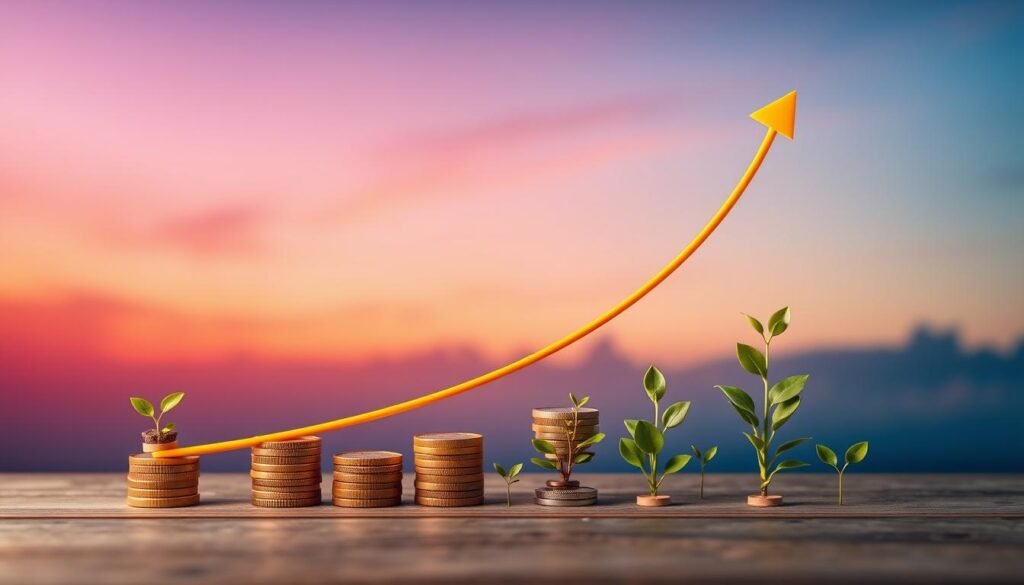The Power of Compound Interest: How to Turn Small Investments into Big Returns
Did you know that a mere $10,000 invested at age 31 could outperform $20,000 invested over a decade starting at age 41 by nearly 15%? This fact shows the amazing power of compound interest in growing wealth1. We’re about to explore how small investments can grow into big returns over time.
Compound interest is often called the eighth wonder of the world. It’s a financial superpower that makes your money grow by earning interest on both your initial investment and the interest it earns. This magic can turn small savings into big wealth, with enough time and consistent contributions.
Here’s an example: a $1,000 investment earning 5% annually would grow to $1,157.63 in just three years through compounding1. This growth is not just impressive; it’s a game-changer for long-term financial planning and wealth building.
In the next sections, we’ll dive into the basics of compound interest, how to make the most of it, and real success stories. Whether you’re starting your investment journey or looking to improve your portfolio, knowing about compound interest is key to reaching your financial goals.
Key Takeaways:
- Compound interest allows earnings on both principal and accumulated interest
- Early and consistent investments maximize compound interest benefits
- Time is a critical factor in compound interest growth
- Reinvesting dividends enhances compounding effects
- Tax-advantaged accounts can boost investment growth
- Diversification helps manage risks and improve returns
- Regular portfolio rebalancing is essential for maintaining optimal asset allocation
Understanding Compound Interest Fundamentals
Compound interest is a powerful financial concept that can significantly impact your wealth over time. Let’s explore its basics and how it can work in your favor.
The Definition and Basic Mechanics
Compound interest is interest calculated on both the initial principal and all previously accumulated interest. This method of interest calculations leads to exponential growth, multiplying savings or debt at an accelerated rate2.
Interest can be compounded at various frequencies, such as daily, monthly, quarterly, or annually. The higher the number of compounding periods, the greater the amount of compound interest2.
How Interest Grows Over Time
The power of compound interest becomes evident as time passes. Consider a scenario where you invest $1,000 annually, earning 8% interest:
- After 10 years, interest earned is 10% of the total balance
- By 20 years, interest accounts for 42% of the total
- At 30 years, interest makes up 90% of the total balance
- After 40 years, interest earned represents a significant 205% of the total balance3
Simple Interest vs. Compound Interest
Unlike simple interest, which only calculates interest on the principal, compound interest accelerates growth. For example, a 3-year loan of $10,000 at 5% interest compounding annually would result in $1,576.25 of interest2.
To illustrate the difference, let’s compare simple and compound interest rates:
| Interest Type | Annual Rate | Compounding | Periodic Rate |
|---|---|---|---|
| Compound | 9% | Monthly | 0.75% per month |
| Compound | 6% | Quarterly | 1.5% per quarter |
| Simple | 7% | Monthly | 0.58.3% per month |
These examples demonstrate how compound interest can lead to higher returns compared to simple interest, over longer periods4.
The Einstein Effect: Why Compound Interest Is Called the Eighth Wonder
Albert Einstein, known for his genius, saw the power of compound interest. He called it “the eighth wonder of the world,” highlighting its ability to grow money exponentially over time5.
Compound interest works by earning interest on interest. This creates a snowball effect, leading to significant wealth over time.

For example, investing £5,000 and adding £2,000 yearly at a 7% return rate can grow to half a million pounds in 40 years and a million in 50 years6. This shows the amazing growth compound interest can offer for long-term wealth.
The rule of 72 helps understand compound interest’s effect. At a 7% return rate, your money doubles every ten years6. This is much faster than cash savings, which would take 720 years to double at a 0.1% interest rate6!
“Compound interest is the eighth wonder of the world. He who understands it, earns it. He who doesn’t, pays it.” – Albert Einstein
The Einstein effect applies beyond traditional savings. In the stock market, profits and dividends often grow faster than the economy, showing compounding in stocks5. To make the most of this, experts suggest a diversified portfolio and avoiding losses in bear markets6.
Grasping the Einstein effect of compound interest is key to long-term financial success. It shows why starting early and investing regularly is vital for building wealth.
Starting Early: The Key to Maximizing Returns
The time value of money is key in growing your investments. Investing early can greatly impact your financial future. Let’s look at how time affects investments and why starting early is important.
The Impact of Time on Investment Growth
Time is a strong ally in investing. A USD 1,000 investment at 5% annual interest grows to USD 1,629 over 10 years with yearly compounding. But, it reaches USD 1,647 with monthly compounding7. This shows how often you compound can change your returns.
Early Investment Scenarios and Examples
Think about this: putting USD 500 monthly into a portfolio with a 7% annual return can grow to nearly USD 610,000 after 30 years7. Even a one-time USD 5,000 investment at 7% annually grows to about USD 38,000 in three decades without more money7. These examples show the power of starting early and letting compound interest work its magic.
The Cost of Delayed Investment
Waiting to invest can have big consequences. Starting at 25 versus 35 can make a huge difference in your portfolio by age 508. This ten-year gap could mean the difference between a comfortable retirement and financial stress. An investment growing at 6% annually doubles in about 12 years, while an 8% return does the same in 9 years7. Every year you delay means missing out on this exponential growth.
Remember, small amounts invested regularly can grow a lot over time8. By understanding the time value of money and starting early, you’re setting yourself up for long-term financial success.
The Mathematical Magic Behind Compounding
The compound interest formula shows how investments grow over time. It turns small amounts into big wealth, key for financial success.
Let’s see how it works. The formula is F = P × [1 + r/n]^(nt). Here, F is the future amount, P is the starting investment, r is the yearly interest, n is how often interest is added, and t is the time in years9.

For example, a $10,000 investment at 10% annual return for 40 years grows to $452,00010. This shows why compound interest is so powerful.
Investment calculations get more interesting when we compare different plans. Let’s look at Ben and Joey’s strategies:
| Investor | Investment Period | Annual Investment | Total at Age 67 |
|---|---|---|---|
| Ben | Age 21-30 | $2,400 | $2.1 million |
| Joey | Age 30-67 | $2,400 | $1.2 million |
Ben’s early start gives him nearly $900,000 more than Joey, even though he invested for fewer years10. This shows how time is key in growing investments.
For exact calculations, online compound interest calculators are handy. They help estimate returns and guide investment choices9. The beauty of compounding is turning small, patient investments into big wealth over time.
Investment Vehicles for Compound Growth
Choosing the right investment vehicles is key for compound growth. We’ll look at popular options to boost your returns over time.
Tax-Advantaged Accounts
Tax-advantaged accounts like IRAs and 401(k)s are great for long-term investing. They let your earnings grow without taxes, speeding up wealth growth. IRAs let you invest in bonds, stocks, and mutual funds11.
Mutual Funds and Index Funds
Mutual funds and index funds are top picks for diversifying your portfolio. They offer professional management and spread risk. Index funds aim to match market indices like the S&P 500, with a 10% return on average12.

Dividend Reinvestment Programs
Dividend reinvestment programs (DRIPs) reinvest dividends back into the stock. This boosts compound growth. Companies known as Dividend Aristocrats, with 25+ years of dividend increases, are great choices12. REITs also pay out at least 90% of their income as dividends each year12.
By using these investment vehicles, you can build a strong strategy for long-term wealth. Remember, compound interest is powerful. With a 7% return, you could double your money in about 10 years12.
The Rule of 72: A Simple Tool for Investment Planning
The Rule of 72 is a great tool for planning your investments. It helps you figure out how long it will take for your money to double in value13.
To use it, just divide 72 by your annual interest rate. This will tell you how many years it’ll take for your investment to double. It’s a simple way to compare different investment options and see how interest rates affect them13.

- With a 6% annual return, an investment would double in about 12 years (72 ÷ 6 = 12).
- At a 9% return, it would take roughly 8 years (72 ÷ 9 = 8).
The Rule of 72 works best for interest rates between 6% and 10%. For rates outside this range, you might need to make small adjustments for more accurate estimates13.
This rule isn’t just for investments. It can also be applied to other financial scenarios:
- Inflation: At 6% inflation, the value of money halves in about 12 years.
- Loans: A 12% interest loan will double the amount owed in six years.
- Fees: An investment with a 3% annual fee will halve in value in around 24 years.
Understanding the Rule of 72 can greatly impact your investment planning. Let’s compare two scenarios with different rates of return:14
| Rate of Return | Initial Investment | Year 10 | Year 15 | Year 20 |
|---|---|---|---|---|
| 5% | $1,000,000 | $1,628,895 | $2,078,928 | $2,653,298 |
| 7% | $1,000,000 | $1,967,151 | $2,759,032 | $3,869,684 |
As shown, a 2% difference in return rate can make a big difference in wealth over time. This highlights the importance of maximizing your returns through smart investment planning and financial calculations14.
Risk Management and Portfolio Balance
Effective risk management is essential in portfolio management. We will look at ways to balance risk and reward. This ensures your investments meet your goals.
Asset Allocation Strategies
Smart asset allocation is key to managing risk. Investors in their 30s and 40s often move to a more balanced portfolio. They mix stocks, bonds, and fixed-income assets15.
Younger investors might choose a more aggressive approach. They might have a higher stock allocation for better long-term results15.
Rebalancing Techniques
Regular portfolio rebalancing is vital for risk assessment. It’s wise to review and adjust your investments at least annually or after major life changes15. This keeps your investment strategy on track and maintains your desired risk level.
Risk Mitigation Methods
Diversification is a powerful tool for lowering investment risk. It involves spreading investments across different asset classes and securities16. Adding alternative investments like real estate or private equity can also help mitigate market risks15.
Historical data shows that longer investment periods significantly reduce the risk of losing money. The chance of loss drops from 1 in 4 for a 1-year investment to zero for a 20-year investment in the stock market16. This highlights the importance of a long-term perspective in portfolio management.
By implementing these strategies, we can harness the power of compound interest while managing risk. Remember, a well-balanced portfolio that aligns with your risk tolerance is key to achieving your financial goals.
Leveraging Time Value of Money
The time value of money (TVM) is key in finance. It shows that money now is more valuable than the same amount later. This is because it can earn more over time17. This idea is at the heart of compound interest and guides our financial choices.
Knowing TVM helps us choose wisely between present and future investments. For example, $10,000 invested at 10% interest for a year becomes $11,00017. This is why starting to invest early and regularly is often advised.
The finance world relies on TVM to show the value of long-term savings and investments18. Investors use it to predict future gains and increase profits18. It’s very useful for planning retirement, where compound interest can greatly increase savings over years.
| Compounding Frequency | Future Value (after 1 year) |
|---|---|
| Annually | $11,000 |
| Quarterly | $11,038 |
| Monthly | $11,047 |
| Daily | $11,052 |
While TVM can lead to significant growth, we must think about inflation and taxes. Inflation can reduce what we can buy, and taxes can cut into investment profits18. These factors highlight the need for diversifying investments and seeking advice from financial experts.
Compounding Frequency and Its Impact
Compounding periods are key to how much you earn on your investments. The more often interest is added, the faster your money grows.
Daily vs. Monthly vs. Annual Compounding
Different compounding frequencies show the power of compounding. For example, $1 million at 20% interest grows differently. It becomes $1,200,000 annually, $1,219,391 monthly, and $1,221,336 daily19. This shows daily compounding gives the highest returns.
Let’s look at a $10,000 investment with 5% annual interest. After 10 years, it grows to $16,288.95. This shows how compound interest can greatly increase your investment19. The Rule of 72 helps estimate doubling time by dividing 72 by the interest rate.
Optimal Compounding Periods
Daily compounding might seem best, but the difference between frequencies is small. For a 4-year investment at 6% interest, monthly compounding gives a slightly higher return than annual20.
| Compounding Frequency | Future Value Factor (4 years, 6% annual) |
|---|---|
| Annual | 1.262477 |
| Monthly | 1.270489 |
| Daily | 1.271364 |
The best compounding period varies by investment. For example, mortgages use monthly compounding. Knowing this helps investors choose wisely and increase their earnings over time.
Common Obstacles to Successful Compounding
We often face challenges when trying to use compound interest. Compound interest can greatly help our finances, but several obstacles can slow it down.
Inflation is a big problem. It slowly takes away the value of our money. Even if our account balance grows, our money’s worth goes down. We need to plan for this to reach our long-term goals.
High fees are another issue. Small fees can add up and hurt our returns over time. A 1% difference in fees can make a big difference in our savings over decades21.
Market ups and downs also pose challenges. Big changes in asset values can hurt our compound returns. For example, if we made 20% one year and lost 20% the next, after 20 years, we’d have just $664.83 for every $1,000 invested21.
| Age Started Investing | Monthly Contribution | Retirement Savings at 65 |
|---|---|---|
| 25 | $100 | $200,000+ |
| 35 | $100 | $100,000 |
Waiting to start investing can cost us a lot. Saving for retirement at 25 instead of 35 can mean about $850,000 less in savings22. This shows how important it is to start early and keep investing.
To beat these challenges, we must be disciplined. We should invest with the market, use trailing stops, and rebalance our portfolios often. Active management is key to overcoming compounding’s downsides and getting better results21.
Strategies for Consistent Investment Growth
Effective investment techniques and wealth building strategies are key for long-term financial success. We’ll look at proven methods to keep your investments growing steadily.
Dollar-Cost Averaging
Dollar-cost averaging is a smart investment strategy. It means investing a fixed amount regularly, no matter the market. This method lowers your average cost per share and lessens the effect of market ups and downs23.
Automatic Investment Plans
Automatic investment plans help you make consistent contributions to your portfolio. This approach keeps you disciplined in your wealth building journey. By investing regularly, you can benefit from compound interest and possibly see your returns grow over time2423.
Reinvestment Strategies
Reinvesting dividends is a strong wealth building tool. Over 20 years, it can double your shares, leading to big compound growth24. This strategy has helped many investors, like Ronald Read, a janitor who built a multi-million dollar stock portfolio through consistent reinvestment24.
Remember, patience and discipline are essential for successful long-term investing. These strategies, along with regular portfolio reviews and rebalancing, can help you navigate market ups and downs. They keep you on track with your financial goals2423.
Real-World Success Stories and Case Studies
Investment success stories show the power of compound interest. They highlight how patience and consistent investing can lead to wealth. We’ve gathered financial case studies to show this.
Warren Buffett’s journey is a great example. His net worth is often in the billions. This comes from strategic investments and compound returns.
For instance, Buffett’s $1 billion investment in Coca-Cola in 1988 is now over $20 billion. His stake in American Express grew from 10% to about 20% thanks to reinvested dividends25.
Let’s look at some real-world scenarios:
- A 25-year-old investing $200 monthly with a 6% return could amass $393,700 by age 65. Starting at 35 would yield only $201,10026.
- Sarah, investing $1,000 at age 20 and contributing $83 monthly, could have $465,000 by age 70. Starting at 30 reduces this to $225,000, and at 40, only $105,00026.
These examples show the importance of early investment. A 20-year difference in starting age can triple your wealth. This is why compound interest is called the “eighth wonder of the world.”25
| Starting Age | Monthly Investment | Total at Age 65 |
|---|---|---|
| 25 | $200 | $393,700 |
| 35 | $200 | $201,100 |
Small business owners can also use compound interest. They can open high-yield business savings accounts and invest in retirement funds. Reinvesting profits can also help. These strategies can greatly increase business savings and investments over time25.
Conclusion
We’ve looked into how compound interest can lead to financial success. It’s often called the eighth wonder of the world. It can make small, regular investments grow into big wealth over time.
The power of compound interest is shown in the doubling penny scenario. A penny doubling every day for a month beats $10,000 daily. It grows to $10,737,418 compared to $310,00027.
We’ve seen how starting early and investing often are key. The rule of 72 helps estimate how fast your money can grow. With a 10% return, your money could double every seven years27.
This shows how important time is in making your money grow.
We’ve also seen how different interest rates can change long-term growth. For example, a $100,000 investment over 30 years with $5,000 added each year could grow to $383,977 at 2% interest. Or it could grow to $2,567,410 at 10% interest27.
These numbers show how important it is to get higher returns. But it’s also key to manage risk by diversifying and rebalancing your portfolio.
By understanding and using compound interest, we can reach our long-term financial goals. The secret to success is patience, consistency, and making smart investment choices. These choices should match your risk level and financial goals28.





February 7, 2025 @ 8:38 pm
Your point of view caught my eye and was very interesting. Thanks. I have a question for you.
March 4, 2025 @ 10:31 am
Your point of view caught my eye and was very interesting. Thanks. I have a question for you.
March 10, 2025 @ 12:05 am
I don’t think the title of your article matches the content lol. Just kidding, mainly because I had some doubts after reading the article. https://accounts.binance.com/register?ref=P9L9FQKY
March 12, 2025 @ 7:32 am
Your article helped me a lot, is there any more related content? Thanks!
July 2, 2025 @ 1:58 pm
Thank you, your article surprised me, there is such an excellent point of view. Thank you for sharing, I learned a lot.
July 2, 2025 @ 10:58 pm
Your point of view caught my eye and was very interesting. Thanks. I have a question for you.
August 16, 2025 @ 1:29 am
I don’t think the title of your article matches the content lol. Just kidding, mainly because I had some doubts after reading the article.